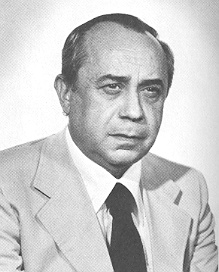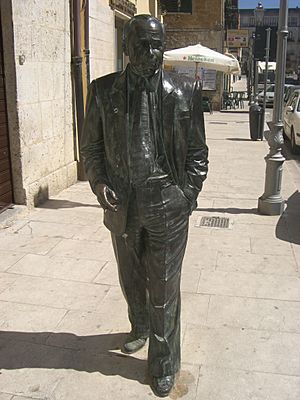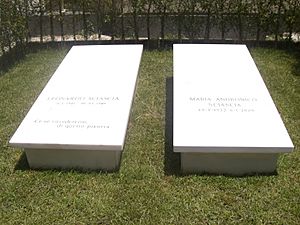Leonardo Sciascia facts for kids
Quick facts for kids
Leonardo Sciascia
|
|
|---|---|
 |
|
| Member of the Chamber of Deputies | |
| In office 20 June 1979 – 10 July 1983 |
|
| Member of the European Parliament for Southern Italy |
|
| In office 10 June 1979 – 16 June 1984 |
|
| Personal details | |
| Born | 8 January 1921 Racalmuto, Sicily, Kingdom of Italy |
| Died | 20 November 1989 (aged 68) Palermo, Sicily, Italy |
| Political party | Italian Communist Party (1975–1977) Radical Party (1979–1984) |
| Residences | Palermo, Sicily |
| Profession | Writer, novelist, journalist, political activist |
Leonardo Sciascia (born January 8, 1921 – died November 20, 1989) was a famous Italian writer, novelist, and politician. He wrote many books, essays, and plays. Some of his stories were even made into movies, like Open Doors (1990) and The Day of the Owl (1968). Sciascia was known for writing about important issues in Italy, especially the Mafia and corruption.
Contents
Life and Early Writings
Leonardo Sciascia was born in a town called Racalmuto in Sicily, Italy, on January 8, 1921. When he was 14, his family moved to Caltanissetta. There, he studied with a teacher named Vitaliano Brancati, who inspired him to become a writer. Sciascia also learned a lot about French writers and American literature.
In 1944, he married Maria Andronico, who was an elementary school teacher. A sad event happened in 1948 when his brother passed away, which deeply affected Sciascia.
His first book, Favole della dittatura (Fables of the Dictatorship), came out in 1950. It was a funny but serious look at fascism, a strict political system in Italy at the time. In 1952, he published his only collection of poems, La Sicilia, il suo cuore (Sicily, its Heart). The next year, he won an award for his essay about another famous writer, Pirandello.
Becoming a Well-Known Author
In 1956, Sciascia published Le parrocchie di Regalpetra (The Parishes of Regalpetra). This book was based on his own experiences as an elementary school teacher in his hometown. It helped readers understand what life was like in small Sicilian towns.
He moved to Rome for a short time in 1957 and made a good friend, the artist Bruno Caruso. That same year, he published Gli zii di Sicilia (Uncles of Sicily), a collection of stories that shared his strong opinions on topics like the influence of the United States and the history of Italy.
After a year, Sciascia moved back to Sicily. In 1961, he wrote one of his most famous mystery novels, Il giorno della civetta (The Day of the Owl). This book was about the Mafia and became very popular. Two years later, he wrote Il consiglio d'Egitto (The Council of Egypt), a historical novel set in Palermo in the 1700s.
In 1965, he wrote a play called L'onorevole (The Honorable). This play openly criticized how some government officials worked with the Mafia. He continued writing political mystery novels, like A ciascuno il suo (To Each His Own), published in 1966.
Writing and Politics
In 1967, Sciascia moved to Palermo. He started writing for a major newspaper, Il Corriere della Sera, in 1969. That same year, he published a play dedicated to Alexander Dubček, a political leader.
Sciascia returned to mystery writing in 1971 with Il contesto (The Challenge). This book was later made into a movie. The novel caused some debate because it showed a harsh picture of Italian politics. His book Todo modo (1974) also caused discussion because of its description of the Catholic Church in Italy.
In 1975, Sciascia became involved in politics himself. He was elected to the city council in Palermo as an independent member of the Italian Communist Party. That year, he also published La scomparsa di Majorana (The Disappearance of Majorana), which was about the mysterious disappearance of a scientist.
He left the Communist Party in 1977 because he disagreed with their dealings with another political group. Later, he was elected to both the Italian and European Parliaments as a member of the Radical Party.
Later Works and Legacy
Sciascia's later works include a collection of essays called Cronachette (1985) and the novels Porte aperte (1987; Open Doors) and Il cavaliere e la morte (1988; The Horseman and Death). He passed away in Palermo in November 1989.
Sciascia's books, like The Day of the Owl and Equal Danger, often showed how the Mafia managed to stay powerful in Sicily. His writing was complex and showed his strong desire for justice. He wanted to reveal how corrupt Italian society had become. He often connected politicians, secrets, and the Mafia in his stories.
Even though he was a private person, his strong opinions made him well-known. He was sometimes disliked for criticizing important figures, like the Prime Minister, for not doing enough to fight crime.
Sciascia wrote about his unique experiences in Sicily, showing how families and political groups were linked, and how favors could lead to unfair outcomes. His books rarely had happy endings or showed justice for ordinary people. For example, in Equal Danger (1973), a detective investigates murders of judges in Sicily. The story shows how authorities struggle to handle corruption, and the hero ultimately fails.
His 1984 book, Occhio di Capra (Goat's Eye), is a collection of Sicilian sayings and proverbs. He gathered these from the area around his hometown, a place he loved very much throughout his life.
List of Books
Here is a list of some of Leonardo Sciascia's works:
- Le favole della dittatura (1950)
- La Sicilia, il suo cuore (1952)
- Pirandello e il Pirandellismo (1953)
- Le Parrocchie di Regalpetra (1956) (Salt in the Wound)
- Gli zii di Sicilia (1958) (Sicilian Uncles) – short stories
- Il Giorno della Civetta (1961) (The Day of the Owl)
- Il consiglio d’Egitto (1963) (The Council of Egypt)
- Morte dell'inquisitore (1964) (Death of the Inquisitor)
- L'onorevole (1965)
- A ciascuno il suo (1966) (To Each His Own)
- Recitazione della controversia liparitana dedicata ad A.D. (1969)
- Il contesto. Una parodia (1971) (Equal Danger)
- Il Mare Colore del Vino (1973) (The Wine-Dark Sea) – collected short stories
- Todo Modo (1974) (One Way or Another)
- La Scomparsa di Majorana (1975) (The Mystery of Majorana)
- Candido, ovvero, un sogno fatto in Sicilia (1977) (Candido, or A Dream Dreamed in Sicily)
- L'affaire Moro (1978) (The Moro Affair)
- Nero su nero (1979)
- Occhio di capra (1984)
- Cronachette (1985) (Little Chronicles)
- La strega e il capitano (1987) (The Captain and the Witch)
- Porte Aperte (1987) (Open Doors)
- Il Cavaliere e la Morte (1988) (The Knight and Death)
- Una storia semplice (1989) (A Simple Story)
See also
 In Spanish: Leonardo Sciascia para niños
In Spanish: Leonardo Sciascia para niños




